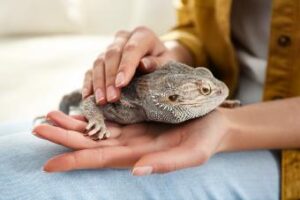If you’ve recently welcomed a bearded dragon into your home or are considering doing so, you’re in for a scaly adventure filled with unique companionship. However, one crucial aspect of caring for these captivating creatures is learning how to pick up a bearded dragon properly.
In this guide, we’ll delve into the art of picking up a bearded dragon, exploring the essential techniques and considerations to ensure a stress-free and enjoyable experience for both you and your scaly friend. So, let’s embark on this journey together as we uncover the secrets of safely lifting and holding your bearded dragon, fostering a bond that will last a lifetime.
Understanding Bearded Dragon Behavior

Understanding bearded dragon behavior is crucial for providing proper care and ensuring the well-being of your pet. Bearded dragons, like any other reptiles, have specific behaviors that are indicative of their health, mood, and communication.
Here are some key aspects of bearded dragon behavior:
- Basking and Cooling: Bearded dragons are ectothermic, meaning they rely on external sources of heat to regulate their body temperature. They engage in basking behavior, where they expose themselves to a heat source to raise their body temperature, and cooling behavior, where they move away to lower it.
- Head Bobbing: Male bearded dragons may exhibit head bobbing as a part of their mating or territorial behavior. This involves a rapid up-and-down movement of the head. Females may also head bob on occasion.
- Beard Puffing: When a bearded dragon feels threatened or is asserting dominance, it may puff out its beard. This is a display of aggression and is often accompanied by other defensive behaviors.
- Arm Waving: Bearded dragons may wave one of their forelimbs, usually in a slow, rhythmic motion. This is a submissive behavior, and they may do it to other dragons or even to their owners.
- Gape Threat: Gaping is a defensive behavior where a bearded dragon opens its mouth wide to display its teeth. This is a warning sign and may be accompanied by hissing. It’s a signal that the dragon feels threatened and may bite if further provoked.
- Tail Behavior: Bearded dragons use their tails for balance, but they may also exhibit tail arching or puffing when they are defensive or agitated. Be cautious, as a stressed dragon may lash its tail.
- Color Changes: Bearded dragons can change color based on their mood, temperature, or health. A darkened coloration might indicate stress or aggression, while a lighter coloration can signify relaxation.
- Burrowing: Bearded dragons have a natural instinct to dig and burrow. Providing a suitable substrate in their enclosure allows them to exhibit this behavior, which can be related to thermoregulation and hiding.
- Eating Habits: Monitoring their eating habits is crucial. Healthy bearded dragons have a good appetite, and changes in eating behavior can be indicative of health issues.
- Brumation: Bearded dragons, like many reptiles, may go through a period of brumation, which is a form of hibernation. During this time, their activity levels and metabolism decrease. Not all bearded dragons go through brumation, and it’s more common in adults.
Observing and understanding these behaviors will help you respond appropriately to your bearded dragon’s needs. Regular interaction, proper husbandry, and a well-designed enclosure contribute to a happy and healthy bearded dragon. If you notice significant changes in behavior or signs of illness, it’s essential to consult with a reptile veterinarian.
How to pick up a bearded dragon
Picking up a bearded dragon requires gentle and careful handling to ensure the well-being of the reptile and to avoid stress. Here are step-by-step instructions on how to pick up a bearded dragon:
- Wash Your Hands: Before handling your bearded dragon, make sure to wash your hands thoroughly with mild soap. This helps remove any scent that might be confusing or frightening to the dragon.
- Approach Slowly: Approach your bearded dragon slowly and calmly. Sudden movements or loud noises can startle them. Allow the dragon to see and acknowledge your presence.
- Use a Flat Hand: Extend your hand toward the bearded dragon with your fingers together and your palm flat. Let the dragon see your hand coming and allow it to approach or sniff your hand.
- Lift from Below: When the bearded dragon is comfortable and seems relaxed, gently scoop it up from below using both hands. Place one hand under its chest and the other under its abdomen. Support its body weight evenly to prevent stress on its limbs.
- Support the Body: Ensure that you support the dragon’s body properly. Bearded dragons have a relatively long body and tail, so make sure you’re not just holding onto the tail. Support the entire body to prevent injury.
- Avoid Squeezing: Do not squeeze or hold too tightly. Bearded dragons have delicate bodies, and excessive pressure can cause injury or stress. Hold them securely but gently.
- Keep a Low Height: When picking up a bearded dragon, try to keep it close to the ground or a stable surface. If the dragon feels insecure or frightened, it may try to jump, and a fall from a height can be harmful.
- Monitor Behavior: Pay attention to the bearded dragon’s behavior. If it shows signs of stress, like puffing up its beard, hissing, or trying to escape, put it back in its enclosure.
- Handle Regularly: To help your bearded dragon become accustomed to handling, practice picking it up regularly. This will help build trust between you and the reptile.
Keep in mind that each bearded dragon has its own personality, and some may be more tolerant of handling than others. Always be patient, and if the dragon seems uncomfortable or stressed, it’s best to put it back in its enclosure and try again later.


